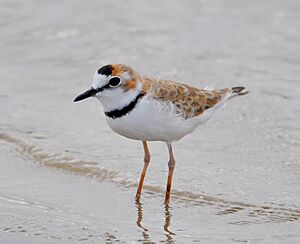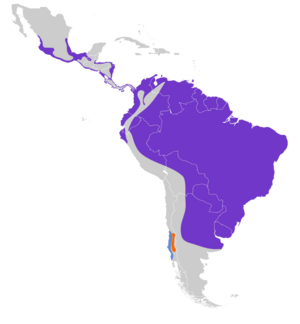Collared plover facts for kids
Quick facts for kids Collared plover |
|
|---|---|
 |
|
| Conservation status | |
| Scientific classification | |
| Genus: |
Anarhynchus
|
| Species: |
collaris
|
 |
|
| Synonyms | |
|
Charadrius collaris (protonym) |
|
The collared plover (scientific name: Anarhynchus collaris) is a small bird that lives near water. It is a type of shorebird from the plover family, called Charadriidae. You can find these birds along the coasts and riverbanks in the Americas. They live in warm, tropical areas and also in cooler, temperate zones. Their home range stretches from central Mexico all the way south to Chile and Argentina.
Contents
All About the Collared Plover
What Does a Collared Plover Look Like?
This small plover is about 18 centimetres (7.1 in) long. That's about the length of a regular pencil! It weighs around 35 grams (1.2 oz), which is less than a small candy bar.
Here are some cool facts about its appearance:
- Its upper parts (back and wings) are brown.
- Its underparts (belly) are white.
- Adult birds have a black band across their chest.
- Male plovers have a white forehead.
- Above the white forehead is a black bar.
- A black stripe runs from their bill to their eye.
- The middle of their head and the back of their neck are chestnut brown.
- Their legs are bright yellow.
When a collared plover flies, you can see its dark flight feathers. It also has a white bar on its wing. The sides of its tail are white too.
How Can You Tell Males and Females Apart?
Female collared plovers usually look very much like the males. Sometimes, you can tell them apart if the female has a brownish tint. This brown tint might appear in areas that are black on the male. Young plovers, called immature birds, do not have any black on their heads. Instead of a black chest band, they have brown patches on each side of their chest.
What Does a Collared Plover Sound Like?
When a collared plover flies, it makes a sharp, metallic sound. It sounds like "pip!"
How Is It Different from Similar Birds?
There are two other plover species that look very similar to the collared plover. They are often found in the same areas.
- The snowy plover is about the same size. But it is lighter brown on its back. It also has dark legs and never has a full chest band.
- Semipalmated plovers are larger. They have thicker bills and a pale collar around their neck.
It's a bit funny, but the collared plover actually does not have a pale collar. This is why it got its English and scientific names!
Where Do Collared Plovers Live?
Collared plovers like sandy coasts and muddy areas near river mouths. They also live on riverbanks inland. You can find them in open, sandy grasslands called savannas. They breed from Mexico south through Central America and most of South America. They also live on some southern Caribbean islands. This includes both Trinidad and Tobago.
These birds usually stay in one place. They do not migrate long distances. However, there is some evidence that they might move a little bit during different seasons.
What Do Collared Plovers Eat?
Collared plovers mainly eat insects. They also eat other small creatures without backbones, called invertebrates. They hunt for food in a special way. They run a little, then stop and look. Then they run again. This is different from some other shorebirds that steadily poke their bills into the ground.
These birds are not very social. They rarely form large flocks. They are also usually very careful and shy around people.
How Do Collared Plovers Raise Their Young?
The time when collared plovers breed changes depending on where they live:
- In western Mexico, they breed from November to December.
- In Costa Rica, they breed from March to June.
- In Venezuela, they breed in January.
- In the lowlands of Ecuador, they breed in March.
When a male plover wants to attract a female, he fluffs out his chest feathers. Then he runs after the female. They do not have any special flying displays during courtship.
Their nest is a simple scrape on the ground. It's just a shallow hollow in the sand or dirt. They make their nests well above the tide line on coasts. On river shores or islands, they build them above the flood line. Inland, nests are often next to low plants, like clumps of grass.
A female plover usually lays two pale, buff-colored eggs. These eggs have brown spots. Like many birds that nest on the ground, adult plovers have a clever trick. If a predator gets too close, they might pretend to have a broken-wing display. This makes the predator think the bird is hurt. Then, the plover lures the threat away from its nest and young.


